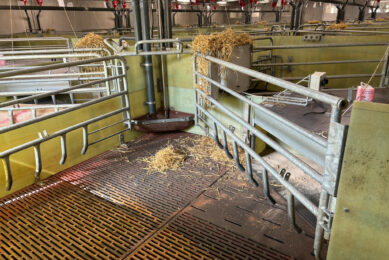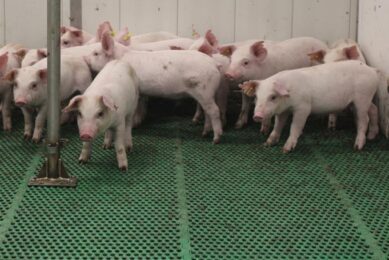Precise feed management at 45th Swine Research Days

The latest edition of the French Pig Research Days, held in Paris, 5-6 February 2013 by the French Pig Research Institute (IFIP) attracting around 500 delegates, of which 100 came from abroad. The main focus was on: How to keep costs low?
About 500 delegates attended the 45th edition of the Swine Research Days or as they are called in French Journées de la Recherche Porcine.
Session moderator Jean Noblet, also research director at the French national institute for agricultural research (INRA), was clear about his perspectives on the swine industry: “Pig production is on the crossroads of numerous technical or societal constraints, and has to face new challenges”.
One way of doing that is by investigating new types of raw materials for feed. Alfalfa, a naturally high source of proteins, is usually only reserved for cattle. Patrick Callu, Arvalis, spoke about the nutritional value of alfalfa protein concentrate for growing pigs. He presented data from three trials on growers fed diets containing alfalfa protein to a concentration of 20%. With regard to the high protein content (57.8% dry matter) and the standardised ileal digestibility of the amino acids (>80%), the alfalfa protein concentrate evaluated in this study yielded an amount of amino acids close to that of soybean meal. Its energy value was relatively high, although lower than soybean meal. Didier Gaudré, IFIP, focused on the inclusion of bakery by-products in diets. The specific raw by-product (dry matter 90%, crude protein 11%, fat 9%, starch 39%) was introduced in pig diets and was compared to a control diet in the post-weaning (9-30 kg) and grow-finishing (30-115 kg) periods. A significant increase (+16%) in the average daily intake with the bakery diet was observed two weeks post-weaning, which tended to improve the ADG by 5% in the six weeks post-weaning. Gaudré added that ‘no detrimental effect was seen in the growing-finishing period and on the lean meat percentage and yield of the carcass’.
Nitrogen
Several presentations focused on nitrogen (N) requirements. Mathieu Gloaguen, INRA, explained that the use of free amino acids in piglet feeds allows to formulate diets with low protein content. Two tests were performed to test the effect of reducing the dietary crude protein content on nitrogen retention and performance in 10-20 kg pigs. In a first experiment, reducing crude protein content from 19.6 to 16.8% had no impact on nitrogen retention and decreased nitrogen excretion by 29%. A further decrease of crude protein content to 14.0 and 12.7% resulted in reduced nitrogen retention. In a second experiment, the performance of pigs was measured. Decreasing the dietary crude protein content from 17.6 to 13.5% had no effect on performance. Growth rate was reduced in pigs receiving the 11.8% crude protein diet. Feeding the diet formulated without soybean meal with 13.0% of crude protein content resulted in reduced feed efficiency but the addition of glutamate to increase the dietary crude protein content from 13.0 to 14.0% restored performance.
Aude Simongiovanni, Ajinomoto Eurolysine, spoke about tryptophane requirements in growing pigs. She performed a meta-analysis to estimate the tryptophane-to-lysine requirement ratio, on a standardised ileal digestible basis that maximises average daily gain, average daily feed intake and gain to feed ratio of pigs between 25-120 kg body weight. A data base of 87 trials was established, and the nutrient composition of diets was recalculated from feed ingredients and information from INRA tables. For pigs of 25 kg and more, she said feed efficiency and growth will be optimised with a standardised ileal digestible basis of 21%, while average daily consumption is maximised with a 20% ratio.
More homogeneous litters
Several presentations focused on sows and litter homogeneity. Florence Loisel, INRA, zoomed in on feeding high dietary fibre to sows in late gestation and its effect on colostrum yield and piglet performance during lactation. She said that in a context of high piglet numbers and high pre-weaning mortality, “the addition of dietary fibre to feed in late gestation seems to be an interesting option” to encourage colostrum intake and piglet survival. Dietary fibre also changes the composition of colostrum and including decreased concentrations of immunoglobulin A.
Litter homogeneity was also a theme for Hélène Quesnel, INRA, who spoke about the impact of supplementation dextrose before insemination and arginine during the third part of gestation. Emmanuel Landeau, Alltech, studied the effect on birth weight of including mannan-oligosaccharides (MOS) in reproductive sow diets. He concluded that the use of MOS during (parts of) gestation resulted in a significant improvement in both uniformity and piglet weight at birth.
Feed presentation
Arnaud Samson, Inzo, zoomed in on the effect of particle size of the calcium carbonate on its nutritional value for pigs. His data showed that the apparent digestibility of Ca at day 35 was affected by carbonate origin and particle size. The phosphorus digestibility was also affected by carbonate source. He said, “Although particle size may affect nutritional value of carbonates, other parameters must be found to improve the nutritional description of carbonates.”
Nathalie Quiniou, IFIP, spoke about the effect of feeding diets in meal or ground pellet form on growth performance and carcass characteristics of grow-finishing pigs when fed restrictively. Until then, the effect was mainly investigated for ad libfeeding conditions. She concluded: “The daily feed intake averaged 2.13 kg with both diet forms; FCR decreased by 5% (2.54 vs 2.66) and the carcass yield was higher with the ground pellets. Carcass leanness tended to be higher for pigs fed with the ground pellets (62.1 vs 61.7%). These effects were more important in barrows compared with gilts. When ground pellets are prepared from a medium fibre diet meal (average particle size of 680 microns), data are consistent with a positive effect of pelleting on dietary energy content, compared to feeding a meal diet.”
Technical excellence
Development strategies are needed in France to increase in competitiveness – and for that reason, a study, presented by Christine Roguet, IFIP, established an exact diagnosis of technical excellence of pig farms in France in 2010. She said that the 20% best performing farms on the standardised margin had better performance on all criteria although not the highest level on each criterion separately. The best farms in 2010 were on average already the best in 2000 and they improved faster. She said that technical excellence is possible in all farm models. It is not the prerogative of very large and specialised structures, but more a matter of individuals. The best farmers are some kind of ‘artisans’ or ‘entrepreneurs’, always looking for improvement. Despite higher fixed costs, a good technical level is accompanied by higher earnings per family labour unit, profit per kg carcass and cash flow.
IFIP also presented the GTE+ method, based on the technical-economic management (GTE) of pig herds, with the addition of accounting data from the farm. Production costs can be obtained for each GTE period, generally over a period of three, four or six months, to allow farmers to be more reactive than with the classic accounting analysis. Moreover, this method makes it possible to forecast production costs, using feed price predictions. This method was applied in about 30 pig farms in Brittany that differed by sow numbers and feed supplies.
Boar taint
One of the best ways to solve problems around breeding boars is to study opportunities in genetics, including genomic selection. For this, a resource population was used. About 1,000 Piétrain type or cross-breed Piétrain x Large White boars were raised and slaughtered to determine the characteristics of sexual development, body composition and above all meat quality traits. Plasma testosterone concentration differed from one genetic type to another, but differences were small. The concentration was not affected by the batch or by the weight of the animals or by their age at measurement. Androstenone content in backfat was not affected by the batch but the average almost doubled from one genetic type to another, the highest levels being observed both in one Piétrain type and in one crossbred type. Androstenone content increased with slaughter weight and plasma testosterone concentration. The effect of slaughter age depended on the genetic type. Skatole content in backfat was little affected by the concentration of testosterone, but varied from one batch to another, from one genetic type to another and decreased with age at slaughter.
Source: Pig Progress magazine 29.2











